
Cast * Interesting Facts * Old Story * New Story * The Music Sweatbox * Songs from Kingdom

Cast * Interesting Facts * Old Story * New Story * The Music Sweatbox * Songs from Kingdom
Directed by... Mark Dindal (Cats
Don't Dance)
Written by: Jonathan Roberts
Music by: Sting &
Marc Shaiman
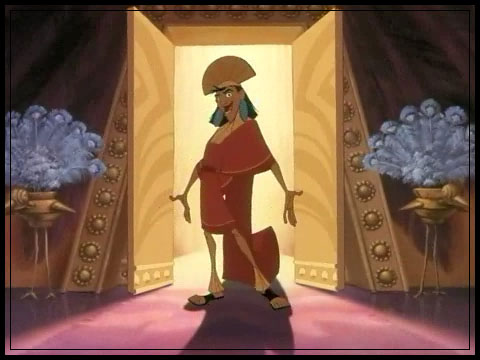
Production Started on: January 15, 1997
Release Date: December 15, 2000
Running Time: 78 minutes
Budget: $80 million
U.S. Opening Weekend: $9.812m on 2,801
screens
Box-office: $89.2 million in the U.S.,
159.8 million worldwide
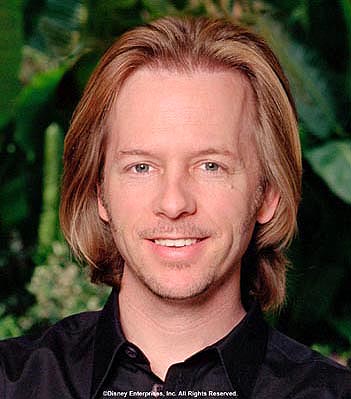 |
 |
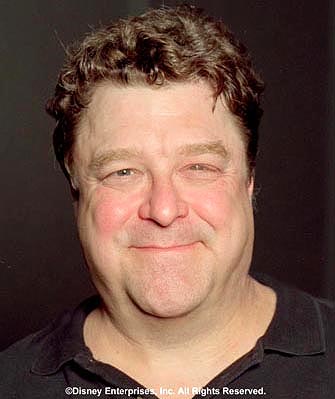 |
 |
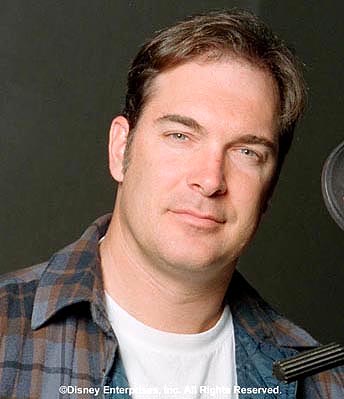 |
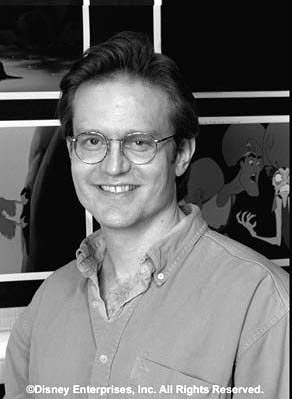 |
 |
Emperor Kuzco... David Spade
Yzma, the sorceress... Eartha Kitt
Pacha, the Llama Herder...
John Goodman
Kronk... Patrick Warburton
Chicha, Pacha's Pregnant Wife... Wendy
Malick
![]() Though a very negative word preceded the movie, the critics were overall
good -describing The Emperor's New Groove as an entertaining and
very funny, though forgettable, movie.
Though a very negative word preceded the movie, the critics were overall
good -describing The Emperor's New Groove as an entertaining and
very funny, though forgettable, movie.
![]() The first trailer for the movie was made available in July 2000, at the
same time as a trailer for Atlantis:
The Lost City which would be released a year later! That along
with the absence of the usual Happy Meal tie-ins, a very discreet press
coverage and modest licensed merchandise, illustrates Disney's choice to
undermarket
The Emperor's New Groove.
The first trailer for the movie was made available in July 2000, at the
same time as a trailer for Atlantis:
The Lost City which would be released a year later! That along
with the absence of the usual Happy Meal tie-ins, a very discreet press
coverage and modest licensed merchandise, illustrates Disney's choice to
undermarket
The Emperor's New Groove.
![]() Yzma originally looked much more like Eartha Kitt, but was redrawn when
the 73-year old entertainer mentioned to the studio that she'd want royalties.
"Now she barely does" admits Eartha herself!
Yzma originally looked much more like Eartha Kitt, but was redrawn when
the 73-year old entertainer mentioned to the studio that she'd want royalties.
"Now she barely does" admits Eartha herself!
![]() Patrick Warburton is also the title voice of the Toy
Story spinoff series, Buzz Lightyear of Star Command:"I
grew up on Disney movies. I was raised with a strict Catholic upbringing,
and one of the only shows we could watch on TV was the Disney Sunday night
movie. When we went to the drive-in, nine out of 10 times it was a Disney
movie. It's part of our heritage. That's probably why they pay so little."
Patrick Warburton is also the title voice of the Toy
Story spinoff series, Buzz Lightyear of Star Command:"I
grew up on Disney movies. I was raised with a strict Catholic upbringing,
and one of the only shows we could watch on TV was the Disney Sunday night
movie. When we went to the drive-in, nine out of 10 times it was a Disney
movie. It's part of our heritage. That's probably why they pay so little."
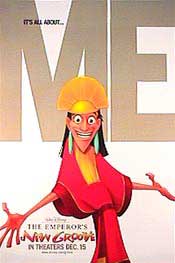
![]() "There
was some press that it was a troubled project and that we were having a
hard time getting it done. That's absolutely not true. It was way worse
than that," confessed jokingly producer Randy Fullmer. "We had been working
for two years on what was essentially an epic version of the Incas in Peru.
We weren't having very much fun; it was too realistic. You can't believe
how much work these films take, and actually, it's even more work when
it's not going well. We showed it to the executives at one point and they
said, 'We don't like it and we're not having much fun.' Later that week,
the head of the studio came to me and said they were close to shutting
it down. Basically, we went back and we had two weeks. At that point, we
literally had no credibility, because we'd been spending two years doing
something they didn't like, but we thought we had a vision for this film
that would be a whole lot more fun than what we were doing. That two weeks
is so frozen in my memory banks. It was so exciting, to spend two years
struggling on something and never quite getting it, then all of a sudden,
everybody had a passion to do what they wanted to do. If there's any lesson
we all learned from this, it's that when you have passion, that's when
things go well. That's when you really know you've clicked. We really had
passion for this second idea."
"There
was some press that it was a troubled project and that we were having a
hard time getting it done. That's absolutely not true. It was way worse
than that," confessed jokingly producer Randy Fullmer. "We had been working
for two years on what was essentially an epic version of the Incas in Peru.
We weren't having very much fun; it was too realistic. You can't believe
how much work these films take, and actually, it's even more work when
it's not going well. We showed it to the executives at one point and they
said, 'We don't like it and we're not having much fun.' Later that week,
the head of the studio came to me and said they were close to shutting
it down. Basically, we went back and we had two weeks. At that point, we
literally had no credibility, because we'd been spending two years doing
something they didn't like, but we thought we had a vision for this film
that would be a whole lot more fun than what we were doing. That two weeks
is so frozen in my memory banks. It was so exciting, to spend two years
struggling on something and never quite getting it, then all of a sudden,
everybody had a passion to do what they wanted to do. If there's any lesson
we all learned from this, it's that when you have passion, that's when
things go well. That's when you really know you've clicked. We really had
passion for this second idea."
![]() The
"second idea" involves David Spade as the titular character, a vain and
nasty ruler who is transformed into a llama by a conniving advisor (Eartha
Kitt). He ends up in the custody of a lowly peasant (John Goodman) and
must swallow his pride to find his way back to the throne. According to
Mark Dindal, the film's director, Spade's involvement was the key to the
story's transformation.
The
"second idea" involves David Spade as the titular character, a vain and
nasty ruler who is transformed into a llama by a conniving advisor (Eartha
Kitt). He ends up in the custody of a lowly peasant (John Goodman) and
must swallow his pride to find his way back to the throne. According to
Mark Dindal, the film's director, Spade's involvement was the key to the
story's transformation.
![]() "In
a very early version of this movie, he only spoke for the first ten minutes,
and then he turned into a llama and didn't speak for the rest of the movie,"
Dindal said of Spade's role. "We found that when that happened, a lot of
the entertainment evaporated as well. We made a choice to take him out
of the supporting role he was in and make him a lead character. This was
a good opportunity to do a different kind of protagonist. Usually you've
got a very warm character who's very sympathetic, and he's a guy who's
just all-out nasty. He's selfish, arrogant and he's got this edgy side
to him. We had a lot of fun with just him being mean to people."
"In
a very early version of this movie, he only spoke for the first ten minutes,
and then he turned into a llama and didn't speak for the rest of the movie,"
Dindal said of Spade's role. "We found that when that happened, a lot of
the entertainment evaporated as well. We made a choice to take him out
of the supporting role he was in and make him a lead character. This was
a good opportunity to do a different kind of protagonist. Usually you've
got a very warm character who's very sympathetic, and he's a guy who's
just all-out nasty. He's selfish, arrogant and he's got this edgy side
to him. We had a lot of fun with just him being mean to people."
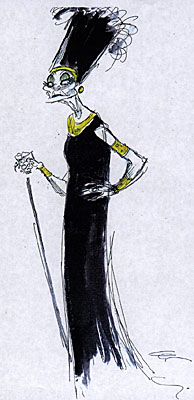
"Ultimately, the point of our film--even though
we'd all like to believe otherwise--is that bad behavior doesn't get you
what you want," Fullmer added. "It doesn't work that way. We cast David
Spade in the role of an arrogant emperor, and he really came through. He
had incredibly bad behavior for us, and it worked out really well."
Above all else, Fullmer and the team simply seemed satisfied that a project with such a turbulent history has finally neared completion. "It actually started when we were working on a film called Kingdom on the Sun. I actually started on that film when I was in the fourth grade," Fullmer joked. "It's been a long time coming. We're really having fun on this one, and that's a good thing."
![]() Disney's effort to lure more Spanish-speaking moviegoers to theaters by
providing a Spanish soundtrack for The Emperor's New Groove turned
out to be a major misjudgment of the Hispanic market. At multiplexes in
Latino areas of Los Angeles where the movie was offered in both English
and Spanish versions, fewer than one-fifth watched the one dubbed in Spanish,
the newspaper said. The dubbed version was quickly withdrawn from most
theaters. "We started out dedicating a screen for an entire week -- and
a holiday week, so we made a pretty big commitment," AMC spokesman Rick
King told the Times. "We subsequently scaled back due to [lack of] demand."
Disney's effort to lure more Spanish-speaking moviegoers to theaters by
providing a Spanish soundtrack for The Emperor's New Groove turned
out to be a major misjudgment of the Hispanic market. At multiplexes in
Latino areas of Los Angeles where the movie was offered in both English
and Spanish versions, fewer than one-fifth watched the one dubbed in Spanish,
the newspaper said. The dubbed version was quickly withdrawn from most
theaters. "We started out dedicating a screen for an entire week -- and
a holiday week, so we made a pretty big commitment," AMC spokesman Rick
King told the Times. "We subsequently scaled back due to [lack of] demand."
![]() Composer Marc Shaiman
recalled in August 2003 that "I had music removed from The Emperor's
New Groove because they thought I was going too Warner Bros. as opposed
to the Disney style. But the Disney people really handled it like gentlemen--we
literally would have all gone to work together on another project that
day."
Composer Marc Shaiman
recalled in August 2003 that "I had music removed from The Emperor's
New Groove because they thought I was going too Warner Bros. as opposed
to the Disney style. But the Disney people really handled it like gentlemen--we
literally would have all gone to work together on another project that
day."
![]() Surprisingly, the movie Disney execs wrote off as a dud out-grossed the
company's supposedly sure-fire holiday hit, 102 Dalmatians.
Despite a shy $10 million opening weekend, The Emperor showed very
strong legs at the box office, going up to $12 million over the New Year
weekend and earning the best reviews Disney got in 2000! Disney,
who was convinced the movie would be a disaster, consequently rolled out
a whole new series of Groove TV commercials to make sure that the
public is aware of the film just prior to the three day Martin Luther King
weekend (the movie earned $8 million in its 6th week).
Surprisingly, the movie Disney execs wrote off as a dud out-grossed the
company's supposedly sure-fire holiday hit, 102 Dalmatians.
Despite a shy $10 million opening weekend, The Emperor showed very
strong legs at the box office, going up to $12 million over the New Year
weekend and earning the best reviews Disney got in 2000! Disney,
who was convinced the movie would be a disaster, consequently rolled out
a whole new series of Groove TV commercials to make sure that the
public is aware of the film just prior to the three day Martin Luther King
weekend (the movie earned $8 million in its 6th week).
![]() Sting was nominated for an Academy Award along with David Hartley for "My
Funny Friend and Me".
Sting was nominated for an Academy Award along with David Hartley for "My
Funny Friend and Me".
![]() Disney collected $125 million in 2001 alone on the video of The Emperor's
New Groove, more than the $90 million it grossed at movie theaters!
It sold over 8 million copies in 2001 alone.
Disney collected $125 million in 2001 alone on the video of The Emperor's
New Groove, more than the $90 million it grossed at movie theaters!
It sold over 8 million copies in 2001 alone.
![]() Jeanine Tesori, the Tony-winning composer of Thoroughly Modern
Millie, revealed in October 2003 that she had finished work on a New
Groove sequel. "I've written three video sequels for Disney--Lilo
and Stitch II, Mulan II, and The Emperor's New Groove II.
I've loved the process. I'd like to take the next year off an concentrate
on a movie."
Jeanine Tesori, the Tony-winning composer of Thoroughly Modern
Millie, revealed in October 2003 that she had finished work on a New
Groove sequel. "I've written three video sequels for Disney--Lilo
and Stitch II, Mulan II, and The Emperor's New Groove II.
I've loved the process. I'd like to take the next year off an concentrate
on a movie."
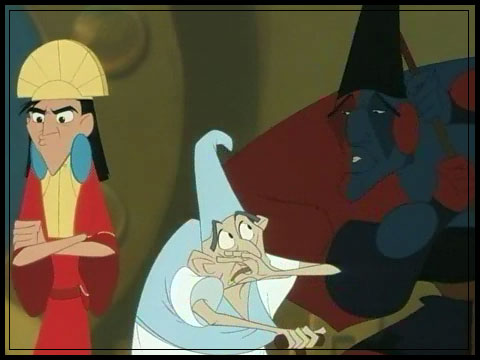 |
 |
 |
 |
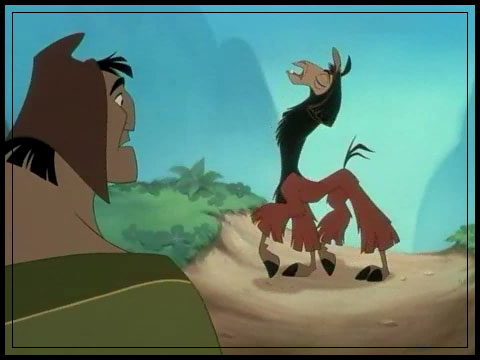 |
![]() In its four years of production, thousands of hours of work and an estimated
$30 millions of dollars of finished animation have been tossed out trying
to find the right tone and story for this film.
In its four years of production, thousands of hours of work and an estimated
$30 millions of dollars of finished animation have been tossed out trying
to find the right tone and story for this film.
![]() As originally planned, " Kingdom of the Sun" (renamed in 1999 "Kingdom
in the Sun") was supposed to be an Aztec adventure based loosely on Mark
Twain's " The Prince and the Pauper". A handsome but haughty prince,
Manco (voiced by David Spade ), discovers that he has an exact look-alike
in a kindly llama herder (voiced by Owen Wilson). To get a taste of freedom,
the prince switches places with the pauper for a day -- little realizing
that the switch has been observed by the evil court sorceress, Yzma (voiced
by Eartha Kitt).
As originally planned, " Kingdom of the Sun" (renamed in 1999 "Kingdom
in the Sun") was supposed to be an Aztec adventure based loosely on Mark
Twain's " The Prince and the Pauper". A handsome but haughty prince,
Manco (voiced by David Spade ), discovers that he has an exact look-alike
in a kindly llama herder (voiced by Owen Wilson). To get a taste of freedom,
the prince switches places with the pauper for a day -- little realizing
that the switch has been observed by the evil court sorceress, Yzma (voiced
by Eartha Kitt).
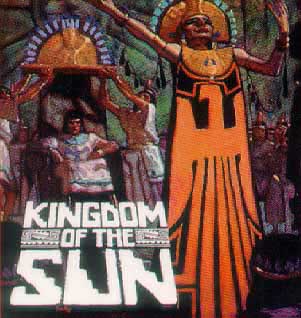
![]() Yzma once was a great looker. Now, she's a painfully thin, faded
beauty -- sort of an Aztec version of Cruella De Vil. Yzma wants desperately
to regain her lost looks. To do this, she'll need the pretend prince to
marshall the full resources of the Kingdom. What must Yzma do to achieve
eternal youth and beauty? Lasso the sun and bring it down to Earth.
Yzma once was a great looker. Now, she's a painfully thin, faded
beauty -- sort of an Aztec version of Cruella De Vil. Yzma wants desperately
to regain her lost looks. To do this, she'll need the pretend prince to
marshall the full resources of the Kingdom. What must Yzma do to achieve
eternal youth and beauty? Lasso the sun and bring it down to Earth.
![]() Therefore, Yzma sees the switch as an opportunity to gain control of the
throne. She uses her magic to turn the pompous prince (when he's disguised
as the pauper) into a llama. The court sorceress then tells the pauper
(who's then masquerading as the prince) that she knows that he's not who
he says he is. Ymza threatens to expose the pretend prince (which would
result in instant beheading) unless he does her bidding.
Therefore, Yzma sees the switch as an opportunity to gain control of the
throne. She uses her magic to turn the pompous prince (when he's disguised
as the pauper) into a llama. The court sorceress then tells the pauper
(who's then masquerading as the prince) that she knows that he's not who
he says he is. Ymza threatens to expose the pretend prince (which would
result in instant beheading) unless he does her bidding.
![]() Meanwhile, there is a sub-plot romance. A young princess called Nina absolutely
despises Manco, but when Pacha takes his place, she starts to like him.
Meanwhile, there is a sub-plot romance. A young princess called Nina absolutely
despises Manco, but when Pacha takes his place, she starts to like him.
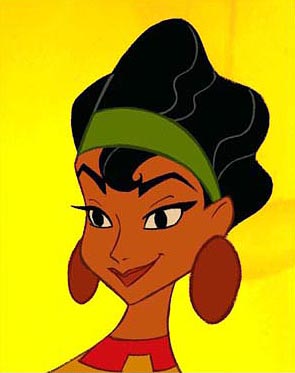
![]() The
trouble with the original story for " Kingdom of/in the Sun " was so he
would turn back into a human. Having finally learned humility through his
experiences as a llama, the prince is finally ready to lead his people.
The pauper would win the hand of a head-strong-but-lovely handmaiden in
the prince's court (who knew that something wasn't quite right when the
pauper was pretending to be the prince). The three of them live happily
ever after ... Yadda Yadda Yadda ... Nothing new here. Just like in dozens
of other Disney animated features
The
trouble with the original story for " Kingdom of/in the Sun " was so he
would turn back into a human. Having finally learned humility through his
experiences as a llama, the prince is finally ready to lead his people.
The pauper would win the hand of a head-strong-but-lovely handmaiden in
the prince's court (who knew that something wasn't quite right when the
pauper was pretending to be the prince). The three of them live happily
ever after ... Yadda Yadda Yadda ... Nothing new here. Just like in dozens
of other Disney animated features
![]() Not
to say that everything in the original version of "Kingdom" was going to
be lame or predictable. Sting wrote several fun pop songs for the film's
score spent over a year animated this very funny little character before
Disney dropped it from the movie. Confesses Sting: "We are exchanging
ideas all the time and generating new possibilities. I write the music,
and then they're supposed to animate it, but there are constantly changes
being made. It's constantly in turnaround. It's enough to make a
person crazy, but that's OK, because I'm crazy anyway. I'm enjoying it.
I accepted because the challenge was writing music for children. It was
something I have never done before, a real shame for a father of six. So,
I was puzzled to see if I could do it or not. It's been a hard task..."
Not
to say that everything in the original version of "Kingdom" was going to
be lame or predictable. Sting wrote several fun pop songs for the film's
score spent over a year animated this very funny little character before
Disney dropped it from the movie. Confesses Sting: "We are exchanging
ideas all the time and generating new possibilities. I write the music,
and then they're supposed to animate it, but there are constantly changes
being made. It's constantly in turnaround. It's enough to make a
person crazy, but that's OK, because I'm crazy anyway. I'm enjoying it.
I accepted because the challenge was writing music for children. It was
something I have never done before, a real shame for a father of six. So,
I was puzzled to see if I could do it or not. It's been a hard task..."
![]() As Disney edited together work-in-progress versions of " Kingdom", it became
obvious that a talented team were doing lots of good work on the project.
But it became obvious that Allers was clueless as to how to fix the film.
Disney Feature Animation head Peter Schneider and Thomas Schumacher then
stepped in and quietly shut down work on the project.
As Disney edited together work-in-progress versions of " Kingdom", it became
obvious that a talented team were doing lots of good work on the project.
But it became obvious that Allers was clueless as to how to fix the film.
Disney Feature Animation head Peter Schneider and Thomas Schumacher then
stepped in and quietly shut down work on the project.
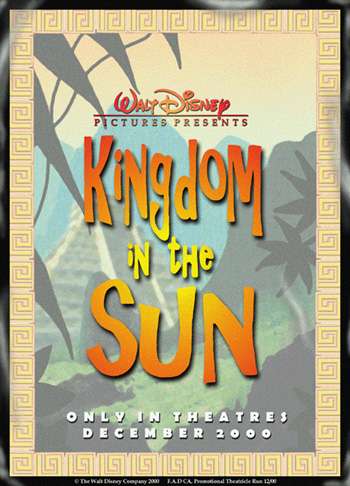
![]() For
six months ( starting in the summer of '98 ), production was shut down
on "Kingdom. " During that time, Disney radically reworked the story while
the film's idle animation team was put to work on Eric Goldberg's " Rhapsody
in Blue" project -which was later decided would be a perfect last minute
addition to "Fantasia
2000".
For
six months ( starting in the summer of '98 ), production was shut down
on "Kingdom. " During that time, Disney radically reworked the story while
the film's idle animation team was put to work on Eric Goldberg's " Rhapsody
in Blue" project -which was later decided would be a perfect last minute
addition to "Fantasia
2000".
![]() Finally tired of waiting for the film's story to be fixed, several of "
Kingdom" 's original animators opted to bail out of the troubled project.
Chief among these was Andreas Deja, the original animator of Yzma. Though
it's said that he did some of his best work ever with the evil sorceress,
Deja had had enough with " Kingdom " 's never-ending story problems. Frustrated
by Aller's inability to fix the film, Andreas opted to get out of town.
He left Burbank and headed to Orlando, where he joined up with Disney Feature
Animation -Florida. Here, Andreas is currently working as the lead animator
on Lilo, the little girl heroine of Disney's forthcoming animated feature,
"Lilo
and Stitch". Based on what the staff down there says, Andreas is genuinely
happier working on "Lilo
& Stitch".
Finally tired of waiting for the film's story to be fixed, several of "
Kingdom" 's original animators opted to bail out of the troubled project.
Chief among these was Andreas Deja, the original animator of Yzma. Though
it's said that he did some of his best work ever with the evil sorceress,
Deja had had enough with " Kingdom " 's never-ending story problems. Frustrated
by Aller's inability to fix the film, Andreas opted to get out of town.
He left Burbank and headed to Orlando, where he joined up with Disney Feature
Animation -Florida. Here, Andreas is currently working as the lead animator
on Lilo, the little girl heroine of Disney's forthcoming animated feature,
"Lilo
and Stitch". Based on what the staff down there says, Andreas is genuinely
happier working on "Lilo
& Stitch".
![]() By 1998, after six months of work (and four years of development), a finished
story board and a third of the final animation completed, Disney's story
department finally decided that the only things that actually worked in
the original version of " Kingdom " were :
By 1998, after six months of work (and four years of development), a finished
story board and a third of the final animation completed, Disney's story
department finally decided that the only things that actually worked in
the original version of " Kingdom " were :
1) The Aztec setting
2) David Spade & Eartha Kitt's performances as the prince and the sorceress.
3) The turning-into-a-llama story idea.
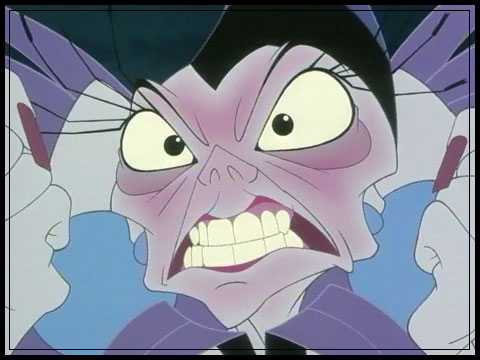
![]() "A
movie begins to emerge as you are making it," Schumacher explained. "It's
a lot like writing a novel or a play. It takes shape over a long period
of time." Producer Randy Fullmer gave one example of how the original
story failed to jell. "We wanted to set it in the 1400s before the
Spanish came [to South America]," Fullmer recalled. "The Spanish brought
the wheel, but we had to have a cart on the storyboard. We debated for
three hours whether to have a wheel on the cart. At the end of the day,
it hit several of us. We are really on the wrong track. We are not trying
to make a documentary on the Incas. We are just trying to have fun.
[At this point] we realized we had missed the boat on our film. We
had sacrificed the potential humour in the movie creating instead an epic
love story with powerful songs. We had taken ourselves and the film too
seriously." Wilson's pauper character was the main focus of the film,
so when Spade's emperor was turned into a llama the character ceased speaking
and became a minor character. "Everyone agreed that when we
didn't have the llama speak, the energy drained out of the movie. If we
let the llama speak, it changed the entire tone of the movie." Heads
were scratched, meetings called and opinions tallied. The result was a
groovier idea. "We decided to go the comic route and make something
really wacky. We brought our new plan to Thomas Schumacher (head of Disney
animation), and he gave us the company's full support."
"A
movie begins to emerge as you are making it," Schumacher explained. "It's
a lot like writing a novel or a play. It takes shape over a long period
of time." Producer Randy Fullmer gave one example of how the original
story failed to jell. "We wanted to set it in the 1400s before the
Spanish came [to South America]," Fullmer recalled. "The Spanish brought
the wheel, but we had to have a cart on the storyboard. We debated for
three hours whether to have a wheel on the cart. At the end of the day,
it hit several of us. We are really on the wrong track. We are not trying
to make a documentary on the Incas. We are just trying to have fun.
[At this point] we realized we had missed the boat on our film. We
had sacrificed the potential humour in the movie creating instead an epic
love story with powerful songs. We had taken ourselves and the film too
seriously." Wilson's pauper character was the main focus of the film,
so when Spade's emperor was turned into a llama the character ceased speaking
and became a minor character. "Everyone agreed that when we
didn't have the llama speak, the energy drained out of the movie. If we
let the llama speak, it changed the entire tone of the movie." Heads
were scratched, meetings called and opinions tallied. The result was a
groovier idea. "We decided to go the comic route and make something
really wacky. We brought our new plan to Thomas Schumacher (head of Disney
animation), and he gave us the company's full support."
![]() So, virtually everything else left over from the previous incarnation of
the film was tossed out. Gone was the "The Prince and the Pauper" under-structure,
Yzma's lassoing-the-sun scheme, supposedly the worst Disney song number
ever (entitled "Llama llama" and featuring two dozens of dancing llamas!)
as well as the characters of Owen Wilson and Harvey Fierstein (as a little
Indian God, Huaca).
So, virtually everything else left over from the previous incarnation of
the film was tossed out. Gone was the "The Prince and the Pauper" under-structure,
Yzma's lassoing-the-sun scheme, supposedly the worst Disney song number
ever (entitled "Llama llama" and featuring two dozens of dancing llamas!)
as well as the characters of Owen Wilson and Harvey Fierstein (as a little
Indian God, Huaca).
![]() The new script for "Kingdom", consequently re-titled "The Emperor's New
Groove", goes as follows : When the sun reaches its apex on his 18th birthday,
snooty prince Kuzco will ascend the throne of the Aztec empire. On that
day, his aged aunt Yzma must step down. Trouble is, Yzma doesn't want to
step down. She wants to continue holding power. So Yzma conspires with
her well-meaning-if-dim-witted henchman, Kronk (voiced by Patrick Warburton,
best known for his work as Puddy on "Seinfeld"), to do the young prince
in.
The new script for "Kingdom", consequently re-titled "The Emperor's New
Groove", goes as follows : When the sun reaches its apex on his 18th birthday,
snooty prince Kuzco will ascend the throne of the Aztec empire. On that
day, his aged aunt Yzma must step down. Trouble is, Yzma doesn't want to
step down. She wants to continue holding power. So Yzma conspires with
her well-meaning-if-dim-witted henchman, Kronk (voiced by Patrick Warburton,
best known for his work as Puddy on "Seinfeld"), to do the young prince
in.
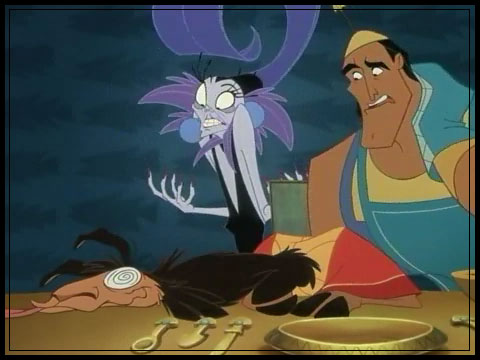
![]() As the prince's birthday nears, Yzma invites her nephew to dinner one night.
During the meal, Kronk is supposed to serve the prince a potion that will
poison him. But he accidentally serves Kuzco a potion that doesn't kill
him but turns him into a llama. Trying to make the best of their botched
plan, Ymza and Kronk then brain the enchanted prince with a vase. Thinking
they've killed Kuzco, they quickly dispose of the body by throwing the
limp llama onto the back of the cart of a peasant (Paucho, voiced by John
Goodman) who's heading out of town.
As the prince's birthday nears, Yzma invites her nephew to dinner one night.
During the meal, Kronk is supposed to serve the prince a potion that will
poison him. But he accidentally serves Kuzco a potion that doesn't kill
him but turns him into a llama. Trying to make the best of their botched
plan, Ymza and Kronk then brain the enchanted prince with a vase. Thinking
they've killed Kuzco, they quickly dispose of the body by throwing the
limp llama onto the back of the cart of a peasant (Paucho, voiced by John
Goodman) who's heading out of town.
![]() Trouble is, Kuzco isn't dead, just unconscious. The next morning, the enchanted
prince comes to in the back of the cart. He finds himself, miles from home
and at the mercy of the cart's owner he's going to put this
Trouble is, Kuzco isn't dead, just unconscious. The next morning, the enchanted
prince comes to in the back of the cart. He finds himself, miles from home
and at the mercy of the cart's owner he's going to put this
lazy talking llama to work...
![]() Meanwhile, with the coronation day approaching, Yzma and Kronk put out
the word that Prince Kuzco has disappeared. Their story is that the young
prince told them that he wasn't up to the challenge of leading a kingdom,
so Kuzco fled in shame. Yzma says that she hopes someday that the prince
will change his mind and return. Til then, she will be happy to stay on
the throne and rule.
Meanwhile, with the coronation day approaching, Yzma and Kronk put out
the word that Prince Kuzco has disappeared. Their story is that the young
prince told them that he wasn't up to the challenge of leading a kingdom,
so Kuzco fled in shame. Yzma says that she hopes someday that the prince
will change his mind and return. Til then, she will be happy to stay on
the throne and rule.
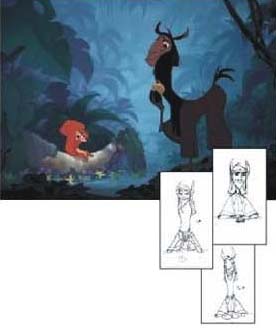
![]() Back out in the countryside, Kuzco learns the value of hard work. He notices
that Paucho and his friends are good, kind hearted people who deserve a
great leader. Humbled by his experience, Kuzco vows to become a good king.
Knowing that the prince has finally learned his lesson, Paucho now offers
to take Kuzco back to the city where they hope to find someone to break
the spell.
Back out in the countryside, Kuzco learns the value of hard work. He notices
that Paucho and his friends are good, kind hearted people who deserve a
great leader. Humbled by his experience, Kuzco vows to become a good king.
Knowing that the prince has finally learned his lesson, Paucho now offers
to take Kuzco back to the city where they hope to find someone to break
the spell.
![]() Meanwhile, word comes to the palace that a talking llama has been sighted
in the countryside. Yzma and Kronk realize that Kuzco must be still be
alive. So they send soldiers from the city to go capture the bewitched
creature...
Meanwhile, word comes to the palace that a talking llama has been sighted
in the countryside. Yzma and Kronk realize that Kuzco must be still be
alive. So they send soldiers from the city to go capture the bewitched
creature...
![]() Good triumphs over evil. The spell is eventually broken. Kuzco becomes
human again, while Yzma is turned into a screeching peacock. Paucho's village
is destroyed by the soldiers, but Kuzco vows to build it back, better than
ever.
Good triumphs over evil. The spell is eventually broken. Kuzco becomes
human again, while Yzma is turned into a screeching peacock. Paucho's village
is destroyed by the soldiers, but Kuzco vows to build it back, better than
ever.
INTERVIEW WITH DIRECTOR MARK DINDAL
From Animation
World Network , November 2000.
Q: What happened after Cats Don't Dance? Did Time Warner close down the Turner animation unit?
 Mark
Dindal: They didn't close it down, but it just seemed to all of us
there that the future was really uncertain. I had had enough of trying
to push a movie through under those circumstances. Then I got a call from
a friend at Disney, Randy Fullmer. We had known each other for quite a
while, 10 years or so since we worked together on Little Mermaid. He was
going to produce Groove and he gave me a call to come back over to Disney.
Mark
Dindal: They didn't close it down, but it just seemed to all of us
there that the future was really uncertain. I had had enough of trying
to push a movie through under those circumstances. Then I got a call from
a friend at Disney, Randy Fullmer. We had known each other for quite a
while, 10 years or so since we worked together on Little Mermaid. He was
going to produce Groove and he gave me a call to come back over to Disney.
I felt I had gotten all of the 'roaming' out of my system, and had really learned a lot of valuable things, and I was really ready at that time to come back to a place that had a history and understood the process of animation.
Q: When was this call?
Mark Dindal: That was the beginning of '97, when we were finishing Cats Don't Dance. I finished and then two months later I started at Disney. I didn't take much time off -- Groove was something they were already working on. I just got on -- I felt like it was an opportunity I didn't want to pass up.
Q: They basically said, 'Would you like to direct this for us?'
Mark Dindal: Well, I started as a co-director with Roger Allers from Lion King. He had been working on this idea for at least a year or a couple of years. I was to come on and be a co-director, which was kind of an apprentice to a director type of role, plus it was an opportunity to get back into the Disney studio.
Q: I understand it started out as a more serious story.
Mark Dindal: It was originally much more epic. Sting was writing songs for it, but it was still more of a serious movie.
Q: It still had the prince turning into a llama?
Mark Dindal: The prince did turn into a llama--that was one of the few things that remains, but once he turned into the llama he was mute, so he didn't speak through the rest of the movie. The prince was not really the main character; it was Pacha the peasant. In New Groove he's played by John Goodman, but originally it was supposed to be Owen Wilson, who was a kid at the time, so it was just a different movie altogether.
Q: The kid became the llama's protector?
Mark Dindal: No it was more like The Prisoner of Zenda or The Prince and The Pauper where the kid substitutes for the prince; it was a completely different story altogether.
Q: Turning into a llama doesn't sound like the premise for a serious story.
Mark Dindal: It wasn't a serious drama like Prince of Egypt. It had comic elements of which the prince's transformation was one. But it had bigger life or death stakes; the serious moments were much more serious than what we did. It did have Eartha Kitt playing the evil character [Yzma]; hers and David [Spade as the vain Prince Kuzco]'s were the two characters that survived our changes.
Q: I understand Allers isn't involved with the film at this point.
Mark Dindal: No. When we shifted the film's focus it turned into something he didn't feel a connection to anymore. He moved on and he's now developing another film of his own.
Q: The current crop of Disney features seem to alternate between serious films with comic elements like Lion King or Tarzan, and more humor-driven efforts like Aladdin or Hercules. The Emperor's New Groove definitely belongs in the latter category. The studio was satisifed this was the best direction to go with the project?
Mark Dindal: As we worked on it, there were several notes in the original version that couldn't seem to be addressed. So we just took a very bold move and went to a different direction altogether, and that became the thing that people responded to and liked. Once we did that it really took off; it was less than two years ago that the change was made.
Q: That's a very short time to turn around a feature.
Mark Dindal: It really was. There was a lot of development art that had been done for the earlier version that inspired things and definitely helped, but as it changed its tone people just jumped on.
It's an amazing bunch of people at the studio. If you give them a clear idea of what to do, you just do that and step out of the way. It's not just the talent that's phenomenal, but there's all the support as well. If you focus on what you want, it can really happen quite fast.
Q: Was there a 'eureka' moment when you realized a humorous approach worked best with the story?
Mark Dindal: For me that's the stuff where my instincts lie. So when we were given the opportunity to make that shift, or at least explore it, I felt liberated. That's just where I tend to go.
Q: When did it happen?
Mark Dindal: That was September, 2 years ago ['98].
Q: What was the catalyst for that?
Mark Dindal: The thing just wasn't jelling. It wasn't coming together to [Walt Disney Studios chairman] Peter [Schneider] or [Feature Animation president] Tom [Schumacher]'s satisfaction. So we needed to do something, or I think there was the option that they would just shelve it and the film simply wouldn't be made. So something needed to be done, and a couple of us had this notion of taking it in this direction. We went with it and there was definitely nothing to lose.
Q: Was the title change dictated by the film's new direction?
Mark Dindal: Definitely. It was formerly Kingdom of the Sun.
Q: Then the pronoun changed.
Mark Dindal: Yes, to Kingdom in the Sun. Kingdom of the Sun sounded much more dramatic. In certain translations around the world it would almost take on a religious tone and that made it sound even more dramatic and not representative of where we were taking the movie.
We had several choices that we came up with for a new title. They were presented to several small focus groups that included kids 6 to 8, all the way up to adults around 45. We got to watch behind the glass. They were told the story, shown the characters, given cards with the different titles on them, and this is the title that in 8 or 9 focus groups was chosen by the majority.
It was really interesting with the children. I heard certain adults say, 'I don't even know what that means,' and when the moderator asked the children, 'What does it mean? Do you understand it?' They went, 'Oh sure!' So it was another one of those things where kids aren't so wrapped up in all this stuff that they can't understand something. They go, 'Oh yeah, he's like changing his attitude.' I thought, 'Wasn't that nice? They just get it.' There's no fuss about it; they were pretty clear. They just looked at each other like, 'Why wouldn't we understand that?' It was really kind of fun to watch their faces as they were given the question.
Q: From the trailer I can see it's coming from a very tongue in cheek direction.
Mark Dindal: It's meant to be fun. It's gonna come out at Christmas--it's just the perfect time for families to go and have a good time. There's a message there that's moral and valid, and it should be fun. I think that it sets you down that path.
Q: The characters look very angular, their design is very sharp-edged; at first glance it doesn't resemble what one might think of as the house 'Disney style.'
Mark Dindal: Perhaps when you see more of the style of the backgrounds. Peter Pan was an influence in terms of the brighter colors we're using, and in what we call the 'pool of light' look. It's very theatrical -- they've lit the set for the place where the character is going to perform. When you look at the backgrounds without the characters, they feel like an empty stage waiting for the actors to come on.
Character design-wise, all the characters were designed by Joe Moshier, who was very influenced by the later years of Milt Kahl [directing animator and character designer on Disney's Sleeping Beauty and The Sword in the Stone]. There was a sense of having a straight look and not an all-round, curved kind of design. He touched all the characters, even the smallest and most insignificant walk-ons. He did them all and it looks really nice to have them have that angled look.
Q: I understand there aren't any songs in the body of the movie.
Mark Dindal: Sting is still in the film--he has a ballad over the closing credits that's about the friendship, the relationship between Pacha and Kuzco. He also wrote the song that Tom Jones sings at the beginning and at the end that bookends the movie and describes the character's transformation.
Q: You're talking about his emotional transformation as opposed to his physical one. But there aren't songs or production numbers throughout the course of the film; there hasn't been a song-free Disney cartoon since The Rescuers Down Under in 1990.
MD: If you don't count the Pixar films.
Q: I'm talking about the traditionally animated features. Were there any qualms about that?
Mark Dindal: They definitely were aware that they had played that hand quite a bit, and they wanted to move into different areas using music. But the music's very important. Everyone realizes the value of music, and the emotional potential of having strong music in a movie, so I don't think music will ever be completely absent. It's just too valuable. So I think you'll see different applications of music and songs in the next movies that are coming up.
Q: The idea of someone turning into a llama reminds me of Lampwick's donkey transformation in Pinocchio; was that an influence?
Mark Dindal: We definitely looked at that. That was much more of a horror moment; this is played for the comedy. Kuzco's completely unaware that he's changing. He continues to be the arrogant insensitive person that he is. He's just babbling on about something, completely oblivious to the fact that the other two characters are watching him and realizing something very strange is happening.
Q: In Saludos Amigos Donald Duck has a run-in with a llama...
Mark Dindal: Yeah, we saw that too. What I really liked in that film was the way they caricatured the South American landscape. Some of our people who went down there said it's not caricatured all that much; it's a very dramatic landscape with breathtaking mountain shapes. I wanted to get that impact -- not to represent anything completely photo-realistically, but to have a sense of how, in your imagination, it seems to be; to create that heightened reality that you see when you go to Disneyland or Disney World. It's the way it looks, but it's better.
Q: You feel good about the film.
Mark Dindal: Yeah I do. As we finish it up we've been listening to the score that's being composed by John Debney. As I was saying earlier, it's amazing what an effect music has upon the picture. It really helps the audience know how they're supposed to feel, because music certainly gives you that cue. The pieces that we've heard either create such dramatic weight or emotional weight, or they let me know its okay to laugh at this point, that Kuzco's being mean but you're supposed to be amused by it and not appalled by it.
It's really fun to watch because we had a terrific scratch score on
the movie, but when you get somebody who's really tailor-making it for
the movie itself with a 90-piece orchestra, boy what a jump it is -- it
feels like a film. Movie music sounds a certain way and does a certain
thing.
 |
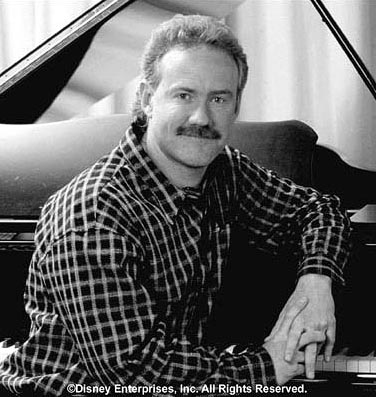 |
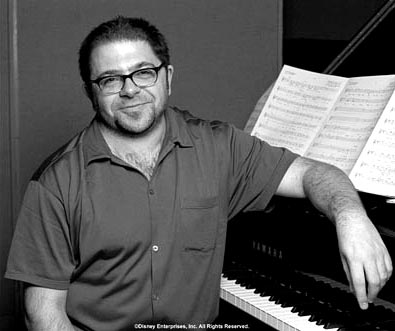 |
In 1997, Sting was asked by the Walt Disney Company to write the music for a new animated feature called Kingdom of the Sun; it was to be directed by Roger Allers, on the heels of his huge hit, The Lion King. Sting agreed, on the condition that his wife, filmmaker Trudie Styler, could document the Disney mode of production.
 When
Walt Disney set up his studio in Burbank, California, the screening room
was a wooden shack with no air conditioning – a historical detail that
suggested the title of this behind-the-scenes documentary, The Sweatbox.
However, the title’s current meaning becomes very clear as, some two years
into the troubled llama drama, the studio machine goes into meltdown. Following
a tense, brutal screening for executives Thomas Schumacher and Peter Schneider,
the original story – an ambitious tale of an emperor who trades places
with a llama herder – was eviscerated.
When
Walt Disney set up his studio in Burbank, California, the screening room
was a wooden shack with no air conditioning – a historical detail that
suggested the title of this behind-the-scenes documentary, The Sweatbox.
However, the title’s current meaning becomes very clear as, some two years
into the troubled llama drama, the studio machine goes into meltdown. Following
a tense, brutal screening for executives Thomas Schumacher and Peter Schneider,
the original story – an ambitious tale of an emperor who trades places
with a llama herder – was eviscerated.
Allers quit. And Sting’s songs were suddenly out of key in a movie that had become a broad comedy about an emperor who tries to regain his throne after being turned into a llama. He was, to say the least, perturbed, and bluntly expresses his disillusionment with Disney’s reductionist treatment of complex cultures.
"At first, I was angry and perturbed. Then I wanted some vengeance," the Grammy-winning musician said. "We couldn't use the songs in this new film because the characters they were written for didn't exist anymore. It is quite dramatic, because everything falls apart. And then it comes back together again. Some of those songs will appear in the making-of movie"
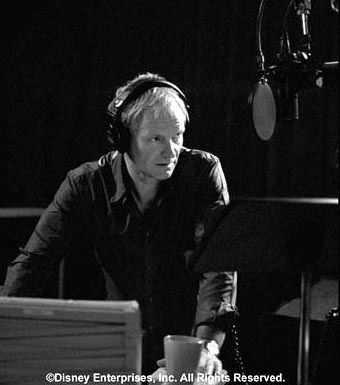 Sting
said his music for the original story aimed for drama like that of the
Oscar-winning work by Elton John in The Lion
King and Phil Collins in Tarzan.
The love story was cut, rendering "One Day She'll Love Me,'' Sting's romantic
duet with singer Shawn Colvin, obsolete. A subplot involving the
villain, a former beauty who blames the sun for prematurely aging her,
also was cut, leaving no room for the song "Snuff Out the Light.'' Other
dramatic songs were cut as well.
Sting
said his music for the original story aimed for drama like that of the
Oscar-winning work by Elton John in The Lion
King and Phil Collins in Tarzan.
The love story was cut, rendering "One Day She'll Love Me,'' Sting's romantic
duet with singer Shawn Colvin, obsolete. A subplot involving the
villain, a former beauty who blames the sun for prematurely aging her,
also was cut, leaving no room for the song "Snuff Out the Light.'' Other
dramatic songs were cut as well.
"In the original version, characters in the movie sang in a more traditional way," director Mark Dindal said. "And as this evolved into the comic tone, that idea didn't fit the sensibility of the movie." Hartley said he and Sting thought their work was finished. "It was a very enjoyable year of writing," he said. "But that was it." But then the fiery behind-the-scenes story found a happier ending.
Disney agreed to release three of the six deleted songs as bonus tracks on the soundtrack album: the villain's theme, the love song and a dance number called "Walk the Llama Llama."
Producer Randy Fullmer said Sting simply was the unwitting victim of a troubled production. While the filmmakers loved the six songs he wrote with collaborator David Hartley, Fullmer said, the movie just wasn't a musical anymore. "I'm not a particularly easy person to call and say, 'We're not using your songs,'" Sting said. "And I didn't make them feel any easier about it." Then came the real blowup - Fullmer asked the angry musician for two new songs -"Perfect World" and "My Funny Friend and Me". "It was hard on him," Fullmer said. "There's no question."
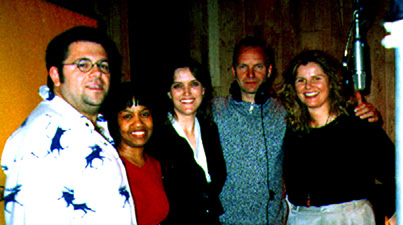 "After
about five minutes of ranting and raving, I thought, 'OK, let's get back
to work. Let's try to make this thing happen,''' Sting said. He and
Hartley wrote two new pieces: "My Funny Friend and Me,'' sung by Sting
during the closing credits, and "Perfect World,'' performed by Tom Jones
as a lounge act in the cartoon. "It's been a very long road, but
I'm happy we got this far,'' Sting said. ``I didn't think we would at one
point.''
"After
about five minutes of ranting and raving, I thought, 'OK, let's get back
to work. Let's try to make this thing happen,''' Sting said. He and
Hartley wrote two new pieces: "My Funny Friend and Me,'' sung by Sting
during the closing credits, and "Perfect World,'' performed by Tom Jones
as a lounge act in the cartoon. "It's been a very long road, but
I'm happy we got this far,'' Sting said. ``I didn't think we would at one
point.''
Meanwhile, Schumacher said he saw footage of Styler's The Sweatbox and isn't nervous about it hurting the studio's image. "I think it's going to be great!" he said. The documentary will include some of the unreleased songs, along with footage of the infamous phone call informing Sting that his songs had been cut. "It's not just a run-of-the-mill making-of film, which is kind of boring," Sting said. "This has got real drama."
Yet it’s not just the juicy machinations of the Mouse House that make The Sweatbox a must-see for animation buffs. The documentary, which recounts a gruelling five-year schedule that consumed two directors, three titles, six songs, millions of animation cels and countless egos, is also a clear-eyed, well-rounded look at the immense effort, dedication and craft required to complete a major animated feature. Footage showing the various stages of animation, intense story meetings, Eartha Kitt’s voice recording (wow!) and privileged glimpses of Sting’s songwriting process are just a few of the pleasures of this illuminating documentary.
The 86-minute Sweatbox documentary, originally
set for release in early 2001, was butchered down into a short DVD feature
renamed "Making the Music Video", and only featuring the Academy Award-nominated
song "My Funny Friend and Me." A cut approved by Disney however got its
worldwide premiere at the Toronto Film Festival in September 2002, and
opened shortly after in one theater in Los Angeles in order to be eligible
for an Academy Award nomination. The Sweatbox should eventually
get released on DVD, likely through Sony Pictures Classics.
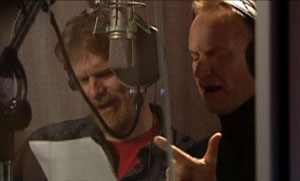 |
 |
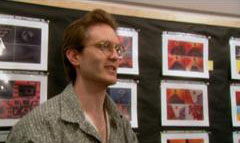 |
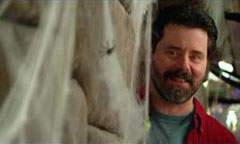 |
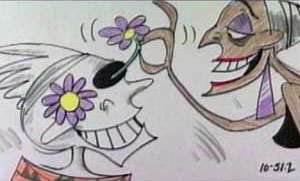 |
As a sidenote, author Michael Koenig claims in
his book Mouse Under Glass that over the years, more than 100 songs
have been written for but then cut from Disney animated features!
"Emperor's New Groove Soundtrack" - Article by Jim Hill for Jim Hill Media (3/12/03)
If you really want to know what you missed out on when Disney canceled "Kingdom of the Sun," you don't want to look at "The Emperor's New Groove" DVD; you want to listen to the "Emperor's New Groove" soundtrack.
Why the soundtrack? Well -- after you pop that CD into your stereo -- take a close look at the soundtrack's liner notes. There, you'll see an odd star shape next to tracks 3, 4, and 7. If you'll check out the teeny, tiny type in the lower left hand corner of the back of the "Groove" soundtrack, you'll see that "these songs were written for but not used in the final film."
That's right, kids. Right there on your copy of "The Emperor's New Groove" soundtrack are three songs that were originally written for "Kingdom of the Sun." If you listen carefully to these tracks -- particularly "Snuff Out the Light" (Yzma's Song) and "One Day She'll Love Me" -- you can get a real sense of the decidedly adult wit and feel director Roger Allers wanted to bring to his version of "Kingdom."
Let me give you a brief synopsis of where each of these songs would have fit into the original storyline of "Kingdom of the Sun":
"Walk the Llama Llama" (Track 4) was actually supposed to be the song that would have introduced "Kingdom"'s central character -- Pacha the peasant llama herder -- to the audience. Mind you, in this version of the film, Pacha wasn't some heavyset middle aged man a la John Goodman. In Pacha's initial incarnation, he was this carefree but good hearted 18 year old llama herder who was a dead ringer for Emperor Manco (which is what Emperor Kuzco was called in the earlier version of the movie). Pacha was to have sung "Walk the Llama Llama" as he lead his trio of llamas down the mountainside and into the marketplace.
As performed by Rascal Flatts on the "Groove" soundtrack, "Walk the Llama Llama" comes across as a pleasant enough ditty. But the animators who worked on the version of "Llama Llama" that was to have been used in "Kingdom of the Sun" actively hated this song. Why? Because they thought that David Hartley's clever lyrics just didn't sound right coming out of a mouth of a supposedly unsophisticated peasant boy. Given that Pacha had never been to the big city before, it just didn't make sense that he'd use words like "panorama" and "the perfect fashion statement."
The animators felt that "Walk the Llama Llama" was just the wrong way to introduce kindly Pacha to the audience. While they enjoyed the bounce and beat of the song, its lyrics gave the wrong impression about who the llama herder was. That's why the "Kingdom" / "Groove" production team wasn't all that upset when "Walk the Llama Llama" ended up getting cut from the film.
"One Day She'll Love Me" (Track 7) -- on the other hand -- was thought to be a real loss for the project by the entire "Groove" production team. Here was this beautifully languid love song, loaded with adult emotions, that would have been a great challenge to stage effectively and animate well.
"One Day She'll Love Me" was originally intended to be used about midway through the movie -- after Pacha has switched places with Emperor Manco. You see, "Kingdom of the Sun" was supoosed to have borrowed quietly liberally from that classic Mark Twain tale, "The Prince and the Pauper." As in: high and mighty Manco has grown bored with being ruler of his mountain kingdom. He discovers that kindly llama herder Pacha is his dead ringer. To get away from the duties of state for a while, Manco proposes that he switch places with Pancha. With the llama herder occupying the throne while Manco cuts loose for a bit. Of course, things don't go according to plan ... and Pacha is forced to stay on the throne, pretending that he's the Emperor. Why? Because Yzma turns Manco into a llama ...
Okay, maybe this story doesn't have as much in common with "The Prince and the Pauper" as I thought ... Anyway ...
The uneasy llama herder had fooled just about everyone at the palace into thinking that he really is the Emperor. But the woman that Manco was betroved to -- the hand maiden, Nina -- has noticed a difference in her soon-to-be husband. Where once he was arrogant and haughty, now the Emperor is thoughtful and kind. Cruelty has inexplicably given way to kindness.
Nina -- who was not looking forward to being Mrs. Manco -- suddenly finds herself drawn to the seemingly transformed Emperor. Pacha also finds himself growing fond of Manco's soon-to-be wife. At a party at the palace, the two teens fight their growing attraction to one another.
This is where "One Day She'll Love Me" would have come in. This song would have been sung over the party sequence, illustrating Pacha and Nina's inner-most thoughts and feelings. There's a heartfelt, yearning quality to the ballad that Sting and David Hartley wrote that would have made this a really magical moment in "Kingdom of the Sun." Folks at Disney Feature Animation say that this song really was one of the better moments in the earlier version of the film.
But -- as "Kingdom"'s complicated Prince-and-the-Pauper-like plotline was dropped in favor of "Groove"'s simpler, sillier story -- there just wasn't a spot in the film anymore for an adult love song like "One Day She'll Love Me." So this genuinely beautiful ballad ended up on the scrap heap -- making it the saddest loss for Disney Feature Animation since Alan Menken and Stephen Schwarz's "If I Never Knew You" got cut from "Pocahontas."
Another real loss for "Groove" was the decision to drop "Kingdom of the Sun"'s villain song, "Snuff Out the Light" [Yzma's Song] (Track 3). This number is considered by many who worked on both versions of the project as the comic highlight of "Kingdom."
So what was so funny about "Snuff Out the Light?" You start with veteran song stylist Eartha Kitt cutting loose with some really witty lyrics. You then add some amazing visuals, as Yzma -- working in a blacklit dungeon that soon fills with wild streaks of color -- is backed up by a trio of comic mummies. The song then builds and builds, with great laughs punctuated by a driving beat. Those who worked on the piece compared it to the "Pink Elephants on Parade" number from "Dumbo." So what's not to like?
Unfortunately, once "Groove"'s production team dropped Yzma's original motivation (in the "Kingdom" version of the story, the aged sorceress had cut a deal with the demon, Supai, to plunge the world into eternal darkness so that the sun could no longer rob Yzma of her beauty), there was no reason for Kuzco's adviser to still sing this song. So "Snuff Out the Light" ended up getting snuffed -- much to the disappointment of the dozens of animators who'd labored for the better part of a year to turn "Snuff" into a comic showstopper.
(Note to Disneyland's Special Events Office: "Snuff Out the Light" is just too good a comic villain's song to let it drift off into obscurity forever. The next time you folks stage one of those "Disney Divas" events, please keep this number in mind, okay? If you throw a halfway decent Yzma impersonator up on stage and get a couple of mummies to back her up, I guarantee you'll stop the show. Don't believe me? Have Feature Animation unearth the work-in-progress version of this "Snuff Out the Light" for you. You'll see for yourself that "Snuff" really was the big one that got away.)
Now, I suppose that all you Disney purists out there are wondering what three songs that aren't actually performed in "The Emperor's New Groove" are doing on the film's soundtrack. There are two answers to that question:
The Fake Answer: With only two songs now being performed in the film -- "A Perfect World" and "My Funny Friend and Me" -- "Groove"'s soundtrack seemed a bit on the skimpy side. Adding "Walk the Llama Llama," "One Day She'll Love Me" and "Snuff Out the Light" to the album helped pad things out, making the recording seem like a better value to retailers.
The Real Reason: The Walt Disney Company really wants to do business with Sting again. They feel badly that most of the songs he wrote for "Kingdom of the Sun" didn't make the cut in "The Emperor's New Groove." By including a few of these dropped numbers on the "Groove" soundtrack, the Mouse is hoping that Sting might look kindly on the Walt Disney Company and be willing to tackle another song writing assignment for an animated feature sometime in the not-so-distant future.
(Memo to Disney Studio Head Dick Cook: Did you actually watch "The Sweatbox?" That behind-the-scenes making-of documentary that film-maker Trudie Styler -- AKA Mrs. Sting -- made about all the turmoil that occurred during the production of "Kingdom of the Sun" / "The Emperor's New Groove"? That seldom seem film should give you some clue as to when Sting might next be willing to work for the Mouse ... several eons from now.)
Anywho ... even though these three songs weren't performed in "The Emperor's New Groove," me personally, I still think that they're a delight to hear. If you really want a clue as to what "Kingdom of the Sun" might have been like, Emily, go pick yourself up a copy of the "Emperor's New Groove" soundtrack. (And feel free to click the link at the bottom of the article to buy it and help support JimHillMedia.com in the process.) Then listen to "Walk the Llama Llama," "One Day She'll Love Me" and "Snuff Out the Light." These three songs will give you some insight into the wit and style Allers wanted to bring to this project.
Okay. I know. This isn't as cool as -- say -- having the work-in-progress
version of Disney's "Kingdom of the Sun" folded in with the extras that
you found on your "Emperor's New Groove" DVD. But as the comic Steven Wright
once so eloquently put it: "You can't have everything. Where would you
put it?"
|
||||||||||||